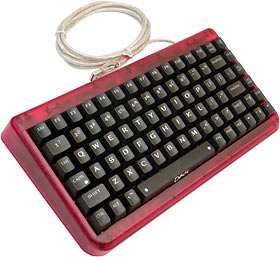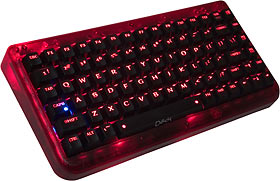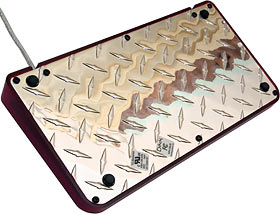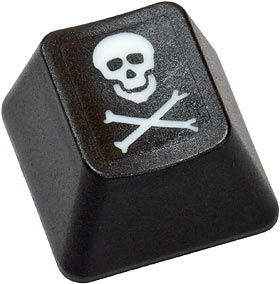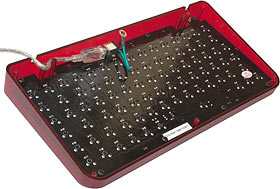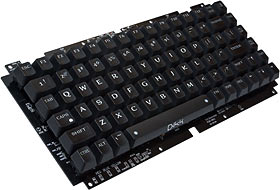
Deck keyboard
Review date: 21 April 2005.Last modified 03-Dec-2011.
I've got a bit of a... thing... about keyboards.
I type a lot, of course, so there's some justification for my keyboard fetishism. If you type a lot, and yet you think one keyboard's much like another, I invite you to use a good 'board - like, for instance, one of my beloved noisy IBM battleships - for a while, and then marvel at the difference it can make.
Plenty of keyboard aficionados don't actually like the buckling spring IBMs very much, simply because they make a lot of noise. Personally, I don't have a problem at all with the two loud clicks per keypress; they make you sound as if you're working twice as hard as you actually are.
If you can't bear the noise of an IBM, though, there are plenty of other options.
We're not talking about the really weird 'boards with split/concave/chording layouts; those can be great for various purposes (chording 'boards let you do full typing with one stationary hand, and some of the more out-there other layouts are apparently Godsends for people afflicted with strain injuries), but you have to learn to type all over again to use anything odder than your basic split 'board.
No, we're talking about keyboards with a normal QWERTY layout, but nice keys.
Nice keys have definite tactile feedback - they let you feel clearly when the switch has made contact. They also have a decent amount of key travel. That rules out all laptop keyboards.
Some laptops have pretty tolerable keyboards - IBM ThinkPads, for instance, but various Dells and Sager/Alienware/ITCs are OK too - but you need a few more millimetres of key-throw for best results.
A lot of people don't know this, though, and use lousy keyboards, even if they type a lot.
Your average $5-at-the-discount-store rubber-dome-switch keyboard has OK key throw but awful feel; you can't tell by feel when the switches make contact, so you end up whacking the 'board much harder than you would if it felt better.
You can spend a lot more money and get an even worse keyboard, though, if you want to show off.
The laser-projected Virtual Keyboard, for instance, took an age to make it to market, and then sucked pretty much as badly as I expected it to all along. Typing on your bare desk is going to take some beating, at least until someone comes up with a desktop version of those flat metal keyboards with skin capacitance detector switches.
More prosaically, there are lots of desktop keyboards out there that use laptop keyboard modules. I've reviewed them now and then. They're slim and sleek, of course, but they're not for heavy typers.
And then, there's keyboards that light up.
They've been around for a while now, and they're marginally useful; if you're typin' in the dark, they save you from having to use a clip-on light or a headlamp or something.
In the real world, though, most people can see their keyboards pretty well by the light of their monitor if they are for some reason computing in a pitch-black room.
People actually buy light-up keyboards because they look so nifty.
Regrettably, though, light-up keyboards also all suck to type on. They mainly use cheap laptop modules, once again - you get translucent key plastic, but if you were blind, you couldn't tell the difference.
But then, there's this.
It's the Deck Keyboard, from established specialty keyboard maker TG3 Electronics.
TGE apparently want there to be an acute accent on the "e", but that'd presumably mean the product name would have to be pronounced "dayk".
I shall, therefore, ignore the innovative typography and move on to the actual product.
It's a USB keyboard.
It glows.
(This is the red model; there are blue and yellow ones, too.)
It's got variable brightness, even. Seven levels of it. Press the laptop-style "Fn" key along with the numbers 1 through 7 for the full faint-to-bright range (or press FN-up-or-down-arrow to step through the levels); Fn-0 turns the lights off.
As you may have noticed, the Deck has a laptop-style keypad-less layout. Good for those on the move, short of space or frightened by high key counts; not so good for people who actually use the keypad.
TG3 promise an add-on USB keypad to match the Deck some time soon; in the meantime, you can of course use any other USB keypad with it. Add-on keypads aren't too expensive these days, and may come with useful extras.
The Deck may only have 84 keys, but it doesn't use a laptop keyboard module. It's a proper long-travel keyboard with good tactile feedback - not quite as positive as buckling spring, but rather quieter - and impressive durability stats.
The specs for the Deck say the keyswitches (with gold contact surfaces, yet) are rated for 50 million cycles. That's a lot. Buckling spring keyswitches are very durable, but commonly only have a 25 million cycle rating; cheap keyboards are, as TG3 say, likely to only be rated for one million cycles, if they're rated at all; quality rubber dome switch keyboards manage maybe ten million.
Let's say you type at a relatively leisurely 40 words per minute (I'm error-free at about 80, with a following wind). At 5.5 characters per word, that's 13200 characters per hour. Naively assuming those characters to be evenly shared among, say, 70 of the keyboard's keys, that's 189 presses per key per hour. 50 million cycles per key will, therefore, last you 265,152 hours, which is about 30 years and three months of non-stop typing.
The Mean Time Between Failures rating for the whole keyboard, however, is a more pedestrian 86,000 hours. As I've discussed before, this doesn't mean anyone's tested one of the keyboards for almost ten years; it just means they've tested a bunch of keyboards for some more sensible period of time, taken the failure rate over that period, and extrapolated it out.
I am insufficiently devoted to quality journalism to spend the next decade or three testing the actual durability of the Deck mechanism, though. I'm willing to believe it's tough.
The Deck lighting system has a similarly over-the-top expected lifespan.
The keyboard is lit, you see...
...by LEDs. One for every key but the space bar, which has one on each end, and the Caps Lock key, which has a blue on-indicator as well as its illuminator LED.
(The brightness adjustment adjusts the Caps Lock light brightness too, which means it's pretty much invisible at the lower brightness settings, and off completely at brightness 0. But hey, maybe you want a completely stealth keyboard. Even the plain low-intensity green LEDs on every ordinary keyboard are bright enough to put circles on the ceiling of a completely darkened room; if you want to keep your home theatre room, planetarium, or Net-connected sniper nest completely blacked out, the Deck can oblige.)
That makes a total of 84 LEDs, all powered from USB (via a see-through lead that has another LED in the plug).
USB can deliver no more than 2500 milliwatts - 500 milliamps at five volts. It'd be dumb to make a keyboard that drew that whole half an amp, though, because it'd only be usable from powered USB ports - the root ports on a computer, or ports on a powered hub. Plug it into an unpowered hub and it probably wouldn't work at all, because the hub itself uses a little power.
Accordingly, the official current requirement of the Deck is 248mA; that's what it reports to the USB controller, which keeps track of the nominal power needs of each device connected to make sure the bus doesn't get over-taxed (and yes, that does mean that simple mobile phone charge cables and fans and lights and other such devices, which just connect to the USB power pins and don't inform the computer of their existence, can screw things up if they push the bus over the limit).
The keyboard itself needs some power to run, of course; the LEDs themselves are running at only 5mA apiece, at full brightness. Red LEDs want about two volts to operate, so 84 of 'em at 5mA need about 840 milliwatts, plus however much power's wasted by the LEDs' driver chips or series resistors (more rambling on this subject here).
LEDs are usually rated to run at 20mA, but they reach their peak efficiency at a pretty small fraction of their rated power, so 5ma doesn't give you a quarter of the rated brightness. What it does give you is an enormous lifespan - TG3 say 200,000 hours for the Deck LEDs, which is plausible. LEDs are usually rated as lasting 100,000 hours at their rated current; this may be a bit optimistic unless they're unusually well cooled, but twice the time from a quarter the current is quite likely. And at the end of their specified life, LEDs don't just go pop like a light bulb; they fade slowly.
Oh sure, you say, it's great that the keyboard and the lights will last forever, but surely the keyboard's casing is ordinary plastic and will break when dropped from only a few storeys up onto a marble floor?
Well, actually, probably not. The Deck's translucent casing's made from polycarbonate, which is one of those substances that'll still be around when our degenerate descendants are farmed for food by giant sentient cockroaches.
And the plate on the bottom of the keyboard...
...isn't quite as tough as it looks - it's aluminium, not steel - but still ought to be proof against an arbitrary amount of pelting.
(I suppose it does depend on what you're being pelted with. No ballistics warranty is expressed or implied.)
Layout
The Deck has a Windows key, but it's in the extreme top right corner of the keyboard, to make it harder to hit by accident.
(Some of us still bear the mental scars from the days of Win95 gaming, when one player pressing a Windows key during a Command and Conquer battle would freeze the game for everyone.)
Below the Windows key there's a vertical row of keys - Home, PgUp, PgDn, End and the right-arrow. Shift and Enter and Backslash and Backspace are all where you'd expect them to be if you're used to an IBM-style keyboard layout (yes the backslash key is in the Right Place), but their width is reduced; I found myself hitting Home instead of Backspace at first.
The inverted-T cursor keys also force the keyboard to have a shrunken right Shift key, so if you normally press right-Shift and apostrophe to get quotation marks, your fingers are going to be bunched up. Or you'll do a cursor-up-and-apostrophe by mistake.
Other oddness: They apparently ended up with extra room for the "1" key, so they made it bigger. And the space bar isn't as tall as the keys around it, because they slope towards the user and it doesn't. This is probably ergonomically connected to the fact that the Deck has no tilt adjustment; the FAQ says that's because people use tilt only "12% of the time".
Well, tilt feet on my keyboards are used 100% of the time, but it's not exactly the Difficult Mod of the Century to stick a couple of tall rubber feet on the back of the keyboard base, so this is no big deal.
Every new and exciting keyboard layout ends up with at least one really odd key location. For the Deck, it's Delete, which is on the bottom row along with Insert and the Fn key. There is no right-Alt or right-Ctrl.
The "Fn" key on a laptop typically does all sorts of things - toggles part of the 'board into acting as a numeric keypad, lets you adjust screen brightness and sound volume (often with Fn plus an arrow key), lets you switch between different LCD and external monitor output combinations, and so on. On the Deck, all it does is brightness adjustment, and switch the function of the single key that's devoted to "Pause/Break" and "PrtSc/SysReq".
Alt-Tabbing on the Deck is a bit tricky, because the tilde/backtick key's to the left of the space bar (odd, but handy for FPS gamers who use that key to access the console). Next come Alt and Ctrl in their usual order, but they're standard-sized square keys, not the rectangles you get on most keyboards. Tab is square, too, so you need considerably better accuracy to press Alt-Tab; get it wrong and the best you can expect is a backtick followed by a tab.
Fiddling
Discerning lunatics with a place in their life for a glowing keyboard that's built like a tank may well like the idea of taking it to bits and modifying it.
TG3 are, surprisingly, totally fine with this. They actually tell you how to take it apart, fix it, paint it (with polycarbonate paint, the same stuff people use to paint most R/C car bodies), change the LEDs - including installing extra ones in pre-existing locations around the edges of the board - and change the keycaps.
Well, you'll be able to change the keycaps when the replacement keycap sets are available, anyway. They aren't, yet. Apparently they'll come with a widget to pull the old caps off, but TG3 also suggest a two-paper-clip method that works well enough.
You do get one replacement keycap with your Deck:
Nice.
Unscrew the baseplate from the Deck and you can get at the end of the USB cable - it's a regular A-to-B plug-in type, so you can replace it with a longer one if you like, and easily replace a dead cable.
It's easy to get the whole keyboard module out, too, in case you want to build it into a desk, or something. Or just wash all of that spilled coffee out.
You won't be finding any of those "warranty void if removed" stickers anywhere on your Deck, by the way. The warranty even covers modified Decks, as long as the modifications weren't excessively amateurish.
(There's a 30 day money back satisfaction guarantee, too, but that only covers unmodified Decks.)
The price
The red, or "Fire" version of the Deck costs $US99, as does the yellow ("Gold") version. The blue "Ice" version's $US119.
You can also buy casings in the standard colours plus black and clear.
This ain't cheap. You can get a whole brand new IBM 'board (different brand, same product) for $US49 plus possibly-surprisingly-expensive shipping. And you can get the latest widely reviewed lit-up 'board, complete with mobile phone ring detecting flashing gizmo, for thirty-something US bucks.
But, of course, the IBM 'board is a giant burglar-stunner of a thing that makes a racket and doesn't light up, and the cheap LED-lit 'board, like every other glowing keyboard, is mechanically laughable compared with the Deck. The Deck's real competition is keyboards like the Happy Hacking models, which start at $US69 for mere ten-million-keystroke-plus keys, and run to more than $US250 (mind you, the top-price model is the one with the Gandalf The White/Darth Vader options).
Overall
Most people don't really care what kind of keyboard they have, because they don't do much typing. Or they do type a lot, but aren't going to worry about their keyboard until their hands seize up.
There are now numerous keyboards, some from quite well-known brands, that sell from reputable dealers for six US dollars or less (plus shipping). If you've got ten whole US bucks to spend, there are literally dozens of options.
If you do minimal typing, then go ahead and get yourself a $US10 keyboard, and a $US5 keyboard; put the cheaper one in the cupboard so you'll have something to tide you over when the other one craps out.
People who like the look of the Happy Hacking 'boards, though, or the seldom-seen 84-key "space saver" IBMs, or some other baby-board, would do well to consider a Deck.
The computing world isn't short of incredible new keyboard ideas, some more bizarre than others; the Deck, in contrast, just takes an idea other companies had already had a swing at, and does it right.
I was perfectly happy with the Deck's key-feel and general ergonomics (after sticking a couple of rubber washers on the back edge to tilt it a bit). I prefer typing on my old IBM battleship, but really only because it's a full keyboard with keypad; I don't need a space-saver keyboard, no matter how good it is.
If you're cool with the space-saver idea (and, remember, you can add a cheapo USB keypad), and want a proper keyboard, not some cheap-switched nasty-board, then the Deck deserves serious consideration even if you don't care about the light-up feature.
If you also like-a da lights, though, the Deck is pretty much the perfect product. Style, and substance.
Recommended.
Review Deck kindly provided by Deck Keyboards.
